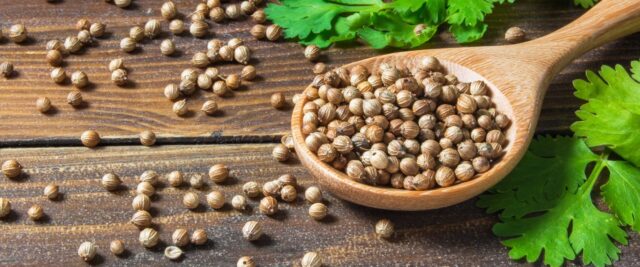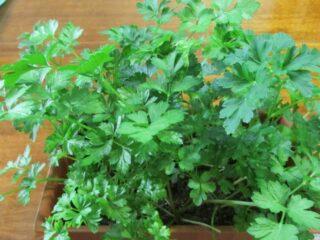Content
Coriander has significant benefits for diabetes. It is due to the fact that the substances that make up the spice activate the synthesis of insulin. Thanks to this, glucose is better absorbed by cells. Therefore, blood sugar levels decrease. But it is worth keeping in mind that in some cases the spice can do more harm than good. Therefore, you can consume no more than 3-4 g of seeds per day.
Is coriander good for diabetes?
Coriander, also called cilantro, is allowed for diabetes. The product is low-calorie, the glycemic index is very low - within 15. There are practically no simple carbohydrates in the composition, so the sugar level does not increase when consumed.
The substances that make up coriander stimulate the synthesis of insulin by the pancreas. Thanks to this, cells better absorb glucose, which allows you to control its concentration in the blood plasma. Therefore, if you have diabetes, it is not only possible, but also necessary, to consume the seeds of this plant.
It is unacceptable to refuse medications and diet.
Beneficial properties of coriander for diabetes
Coriander seeds contain many vitamins, minerals and other beneficial compounds:
- vitamins of group B (B1, B2, B5, B6, B9), A, C, K, E, PP;
- organic acids;
- routine;
- tannins;
- essential oil;
- terpenoids;
- potassium;
- magnesium;
- manganese;
- phosphorus;
- calcium;
- copper;
- zinc;
- selenium;
- iron;
- dietary fiber (fiber).
Due to its rich chemical composition, coriander provides great benefits for diabetes. It enriches the body with vitamins, improves metabolic processes, and prevents dangerous complications of hyperglycemia. Coriander does not increase blood glucose levels. It stimulates insulin synthesis. Therefore, simple sugars successfully enter cells, which is especially important for diabetes.

Coriander can be purchased as seeds or ground as a spice.
Calories and glycemic index
Cilantro is a low-calorie food, so it can be consumed for both types of diabetes. The calorie content of the seeds is 279 kcal per 100 g. But they are used in small quantities, for example, 10 g, which corresponds to a maximum of 28 kcal.
Nutritional value per 100 g:
- proteins – 21.9 g;
- fats – 4.8 g;
- carbohydrates – 41.7 g.
The benefit of coriander for diabetes is also that it has a very low glycemic index. Like other edible greens (dill, parsley, onion), it is in the range of 5-15 (for comparison: dried peas 25, buckwheat 45).
The index shows how quickly consuming a particular product raises blood glucose levels.The scale consists of 100 units, where the maximum value corresponds to pure sugar (sucrose). Since coriander has an index of no more than 15, it can be safely used for diabetes mellitus types 1 and 2.
Coriander also has a beneficial effect on other body systems:
- relieving joint pain;
- protection against free radicals;
- prevention of premature aging processes;
- improving sleep, eliminating insomnia;
- reduction of bad cholesterol levels;
- prevention of cardiovascular pathologies;
- antibacterial effect;
- diuretic effect.
How to use coriander for diabetes
When consuming, it is worth remembering that it is recommended to use no more than 4 g of seeds (a large pinch) and no more than 35 g of greens per day. This is the optimal norm that must be observed both for diabetes and healthy people. Exceeding the norm is fraught with unpleasant consequences.
There are several proven recipes for using coriander for type 2 diabetes. For example, you can prepare a decoction. The sequence of actions is as follows:
- Measure out 5 g of seeds (small heaped teaspoon).
- Grind thoroughly in a mortar.
- Pour into a glass of boiling water.
- Keep in a water bath for 5 minutes at a low boil.
- Leave and cool to room temperature.
- Take several times a day between main meals.
- The course of treatment is long, 2-3 months. Then take a break and repeat the therapy if necessary.

Whole seeds are used to treat the disease.
Harm and side effects
Plant seeds can bring not only benefits, but also harm.If you use them in large quantities for a long time, the following consequences may occur:
- indigestion;
- insomnia;
- renal dysfunction;
- problems with the menstrual cycle;
- rashes, skin irritation and other allergic reactions.
Contraindications to the use of coriander for diabetes
Coriander is often used against diabetes. But it is worth remembering that in some cases it is contraindicated:
- thrombophlebitis;
- hypertension;
- recent heart attack;
- diseases of the gastrointestinal tract (ulcers, gastritis, pancreatitis, cholecystitis);
- tendency to increased blood clotting;
- disturbances in the functioning of the heart muscle;
- individual intolerance to any component.
During pregnancy, coriander can be consumed in moderation (2-3 g per day). It acts as a diuretic and helps remove excess fluid from the body, causing swelling to go away. During breastfeeding, seeds should be used with caution, no more than twice a week. You need to start with small quantities, monitoring the child’s health. If allergic reactions occur, stop taking the drug immediately. It is recommended to consult a doctor for advice.
Conclusion
Coriander for diabetes is allowed to be consumed in moderation. The seeds are used as an additional treatment. A decoction is prepared from them. They should also be added to dishes, for example, to complement meat or vegetables. It is important to follow the recommended daily intake - no more than 4 g.








